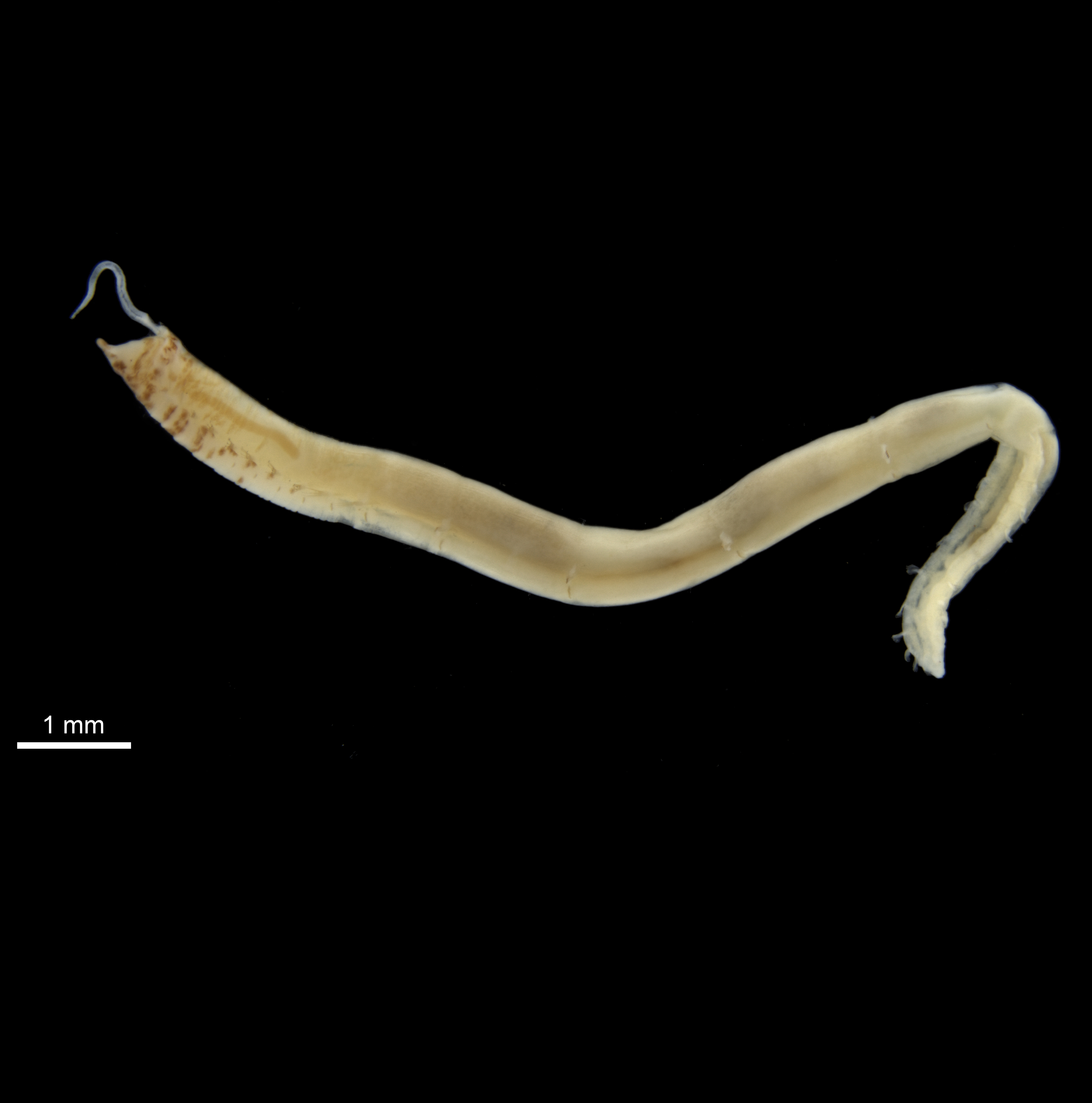Eclysippe eliasoni
Eclysippe eliasoni can be up to 17 mm long. It can be found along the entire Norwegian coast in depths between 15 and 1000 meters.
Type locality
Beaufort, North Carolina, USA, 200 m.
Key characters
Anterior end (head), dorsal view.
pa: paleae
Measurements: Up to 17 mm long.
Number of thoracic chaetigers, excluding paleae: 15
Number of thoracic uncinigers: 12
Number of abdominal uncinigers: 12
Prostomium: Triangular in dorsal view; trilobed; one pair of eyespots.
Mouth tentacles: Smooth.
Branchiae: Three pairs of branchiae in two groups separated by distance equal to about one branchial base diameter; branchiae in each group in transverse row.
Paleae: Long with filiform tips, 4–10 chaetae on each side; paleae are on conspicuous, anteriorly oriented notopodia which are nearly fused with branchiae giving the impression of four pairs of branchial bases when branchia are lost.
Special features: Posterior four thoracic segments clearly longer than preceding segments with notopodia joined by ciliated band across dorsum; posterior notopodia with ciliated dorsal and ventral lobes.
Pygidium: With two lateral rounded lobes.
Tube: Thin, weak layer of organic secretion incrusted with sand grains.
Distribution
Entire Norwegian coast; from 15 m (Holthe 1986a) to 1065 m (Jirkov 2001).
Remarks
The genus Eclysippe was established by Eliason in 1955 for the species Lysippe vanelli Fauvel, 1936, originally described from the shelf areas off the Atlantic coast of Morocco. Eliason examined specimens from Sweden, and although he noted some morphological differences, he considered his specimens belonging to E. vanelli. In 1973, Day described a new species, E. eliasoni (originally as Samythella) from off North Carolina, USA, and considered the specimens reported by Eliason from Sweden (as E. vanelli) to belong to the same species. According to Day, E. eliasoni differs from E. vanelli in the presence of distinctly longer paleae. Eclysippe eliasoni is described to have 13–14 abdominal chaetigers, whereas the specimens from the northern Europe only have 12 abdominal chaetigers, and the name E. eliasoni has not been generally accepted for specimens from the northern European waters.
While working on material from West Africa we found specimens of Eclysippe which were more in accordance with Fauvel’s original description of E. vanelli, having short paleae and brown spots on the anterior part of the body. Examination the holotype of E. eliason revealed that the type only had 12 abdominal chaetigers. No other morphological differences were found between the type of Eclysippe eliasoni (the type is broken in two parts and is in poor condition) and the specimens from the Northern European waters.
Eclysippe vanelli is not likely to occur in Norwegian waters. More comparative work is needed, both morphological and genetic, to determine whether E. eliasoni is distributed both in the North-Western and the North-Eastern Atlantic Ocean. For now, we choose to treat the Eclysippe occurring in Norwegian waters as E. eliasoni.
Similar species
The long paleae on conspicuous, anteriorly oriented notopodia, in combination with the four elongated thoracic segments, makes Eclysippe eliasoni very characteristic. However, specimens of Eclysippe from Norwegian waters have traditionally been identified as Eclysippe vanelli, which is a Western African species and is unlikely to occur here. Eclysippe vanelli is described to have short paleae and brown spots on anterior part of the body, while specimens of Eclysippe from Norwegian waters have long paleae and no such pigmentation, which are more in accordance with the original description of Eclysippe eliasoni.
Sources
Day JH (1973). New polychaeta from Beaufort, with a key to all species recorded from North Carolina. NOAA Technical Reports, Ser. National Marine Fisheries Service, Circulars 375: 1-140. http://dx.doi.org/10.5962/bhl.title.62852
Eliason A (1955). Neue oder wenig bekannte schwedische Ampharetiden (Polychaeta). Göteborgs Kungliga vetenskaps- och vitterhets-samhälles handlingar (B) 6 (16): 1-17.
Fauvel P (1936). Contribution à la faune des annélides polychètes du Maroc. Mémoires de la Société des sciences naturelles du Maroc 43: 1-143.
Personal observations, Alvestad T.
Siden siteres som:
Alvestad T og Budaeva N (2020). Eclysippe eliasoni (Day, 1973). www.artsdatabanken.no/Pages/299311. Nedlastet <dag/måned/år>
)
)
